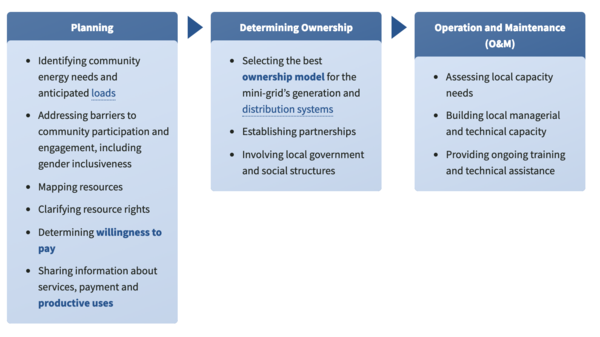Knowledge fuels change
For over a decade, Energypedia has shared free, reliable energy expertise with the world.
We’re now facing a serious funding gap.
Help keep this platform alive — your donation, big or small, truly matters!
Thank you for your support
Difference between revisions of "Community Engagement"
***** (***** | *****) m (→Introduction) |
***** (***** | *****) m (→Nepal) |
||
| (3 intermediate revisions by the same user not shown) | |||
| Line 1: | Line 1: | ||
| − | |||
= Introduction = | = Introduction = | ||
| − | The main aim of the energy projects is to serve the target community. Therefore, it is highly important to engage with the target community before, after or during the energy projects, to understand their needs and demand. This will ensure the involvement of the community in the project and help in successful execution of the project. Community engagement should also take into account the fair representation of women, indeginous groups and other minorities groups who previously did no have a say.<ref>https://www.usaid.gov/energy/mini-grids/community/engagement</ref> A study in India also found that community-based mini-grid projects are especially effective when the community | + | The main aim of the energy projects is to serve the target community. Therefore, it is highly important to engage with the target community before, after or during the energy projects, to understand their needs and demand. This will ensure the involvement of the community in the project and help in successful execution of the project. Community engagement should also take into account the fair representation of women, indeginous groups and other minorities groups who previously did no have a say.<ref>https://www.usaid.gov/energy/mini-grids/community/engagement</ref> A study in India also found out that community-based mini-grid projects are especially effective when the community members are active stakeholders.<ref name="https://www.powerforall.org/resources/fact-sheets/fact-sheet-india-mini-grids">https://www.powerforall.org/resources/fact-sheets/fact-sheet-india-mini-grids</ref> |
Community engagement at different stages of the project is shown below: | Community engagement at different stages of the project is shown below: | ||
| Line 8: | Line 7: | ||
Community engagement is usually an overlooked topic during energy project planning. This article summarizes all the articles on energypedia concerning this topic. Please add your experiences and questions to this article! | Community engagement is usually an overlooked topic during energy project planning. This article summarizes all the articles on energypedia concerning this topic. Please add your experiences and questions to this article! | ||
| + | <br/> | ||
= Community Engagement - Relevance = | = Community Engagement - Relevance = | ||
| Line 15: | Line 15: | ||
= Examples for Different Technology Approaches = | = Examples for Different Technology Approaches = | ||
| − | *<span style="font-size: 13.6px; | + | *<span style="font-size: 13.6px; background-color: rgb(255, 255, 255)">[[Lessons Learnt for Community Based Pico- and Micro-hydropower Schemes|Lessons Learnt for Community Based Pico- and Micro-hydropower Schemes]]</span> |
*[[Community Involvement in Mini-grids|Community Involvement in Mini-grids]] | *[[Community Involvement in Mini-grids|Community Involvement in Mini-grids]] | ||
| Line 23: | Line 23: | ||
*[[Participatory Management (PM) Approach for Achieving Rural Electrification|Participatory Management (PM) Approach for Achieving Rural Electrification]]. | *[[Participatory Management (PM) Approach for Achieving Rural Electrification|Participatory Management (PM) Approach for Achieving Rural Electrification]]. | ||
| + | *[[Community Rural Electrification Programme (CREP) Nepal|Community Rural Electrification Programme (CREP) Nepal]] | ||
| + | |||
== Kenya == | == Kenya == | ||
| Line 29: | Line 31: | ||
*[[Community Engagement for Power Projects|Community Engagement for Power Projects]] | *[[Community Engagement for Power Projects|Community Engagement for Power Projects]] | ||
*[[Community Engagement in Kenya|Community Engagement in Kenya, social licences]] | *[[Community Engagement in Kenya|Community Engagement in Kenya, social licences]] | ||
| + | |||
| + | == Indonesia == | ||
| + | |||
| + | *[[Community_Management_Guide_for_Mini-grid|Community Management Guide for Mini-grid]]<br/> | ||
| + | |||
| + | == Guatemala == | ||
| + | *[[Private Sector Financed Community Solar Microgrids and Agricultural Accelerators|Private Sector Financed Community Solar Microgrids and Agricultural Accelerators in Guatemala]] | ||
= Further Information = | = Further Information = | ||
| Line 39: | Line 48: | ||
= References = | = References = | ||
| − | <references/> | + | |
| + | <references /> | ||
[[Category:Community_Power]] | [[Category:Community_Power]] | ||
Latest revision as of 14:22, 26 February 2019
Introduction
The main aim of the energy projects is to serve the target community. Therefore, it is highly important to engage with the target community before, after or during the energy projects, to understand their needs and demand. This will ensure the involvement of the community in the project and help in successful execution of the project. Community engagement should also take into account the fair representation of women, indeginous groups and other minorities groups who previously did no have a say.[1] A study in India also found out that community-based mini-grid projects are especially effective when the community members are active stakeholders.[2]
Community engagement at different stages of the project is shown below:
Community engagement is usually an overlooked topic during energy project planning. This article summarizes all the articles on energypedia concerning this topic. Please add your experiences and questions to this article!
Community Engagement - Relevance
See also social risks in energy projects.
Examples for Different Technology Approaches
- Lessons Learnt for Community Based Pico- and Micro-hydropower Schemes
- Community Involvement in Mini-grids
Experiences in selected countries
Nepal
- Participatory Management (PM) Approach for Achieving Rural Electrification.
- Community Rural Electrification Programme (CREP) Nepal
Kenya
- Kenya: Best Practice Case Studies
- Community Engagement for Power Projects
- Community Engagement in Kenya, social licences
Indonesia
Guatemala
Further Information
- Portal:Energy Access
- Energy Planning for Rural Areas
- Rural Electrification
- Community Power
- Energy Transition in Germany “Energiewende” and Financial Solutions for Innovation and Sustainable Development in the Energy Sector - FINE Project (BMBF)




















